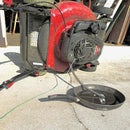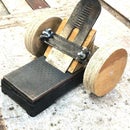Introduction: Parallel Parking 1-2-3
One of the more difficult skills to learn as a new driver is parallel parking. Kiteman did an Instructable on it in 2007. I wanted to add something I use to make it a 1-2-3 operation easier to learn. Kiteman's Instructable was designed for the United Kingdom. Mine is more for the USA, although basic principles could translate between the two.
(The photo is from Google Images.)
(The photo is from Google Images.)
Step 1: "1"
Find a space and pull alongside the vehicle at the front of your space.
I used red paper to represent vehicles. The long green stripe represents the curb. The smaller green rectangles are the front wheels. Your vehicle should be away from the parked vehicles about the normal amount of separation you have when driving down the street.
I used red paper to represent vehicles. The long green stripe represents the curb. The smaller green rectangles are the front wheels. Your vehicle should be away from the parked vehicles about the normal amount of separation you have when driving down the street.
Step 2: Turn the Wheels and Begin Backing
Turn the wheels fairly sharply and begin backing, but how sharply? Notice the yellow arrow. The next step explains its significance. It is what makes parallel parking easy.
Step 3: The Target
Make an imaginary line on the car behind your space that is just a bit toward the center of the car from the halfway mark between the headlamp on the street side and the manufacturer's emblem at the center of the car. Another imaginary line that extends the street side of your car will aim for this imaginary mark on the car behind. You can imagine this easily as you look down the side of your car in your driver's side mirror.
(The photo is from Google Images.)
(The photo is from Google Images.)
Step 4: "2"
When you imagine a line running down the driver's side of your car that points at the imaginary line between the headlamp and the maker's emblem on the car behind you, straighten your wheels. Continue backing until your right front bumper is even with the rear bumper of the car ahead of your space (yellow line), begin turning the steering wheel fairly sharply as if you were making a left turn. In the graphic, the yellow arrow points a little nearer to the center of the car behind than it really would. You can gauge how much to turn by watching your left rear fender. It should begin to swing into line with the front left fender of the vehicle behind you.
Step 5: "3"
When the front of the car has swung into the space, the rear of the car should be aligned with the front of the car behind.
Step 6: Pull Ahead a Little
Straighten your front wheels and pull ahead to even the space in front of and behind your car.
If a parking space is longer than necessary, adjustments to this process are pretty intuitive. If the space is a bit shorter than normal, aim initially closer to the center of the car behind and turn the wheels more sharply when your bumper clears the car ahead of yours.
With only a little practice, you can zip into a parallel parking space in three easy steps without jockeying to make the car fit the space. It is rather impressive to watch. People riding with you will be amazed. People stopped behind you as you park will be appreciative.
If a parking space is longer than necessary, adjustments to this process are pretty intuitive. If the space is a bit shorter than normal, aim initially closer to the center of the car behind and turn the wheels more sharply when your bumper clears the car ahead of yours.
With only a little practice, you can zip into a parallel parking space in three easy steps without jockeying to make the car fit the space. It is rather impressive to watch. People riding with you will be amazed. People stopped behind you as you park will be appreciative.











